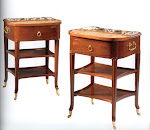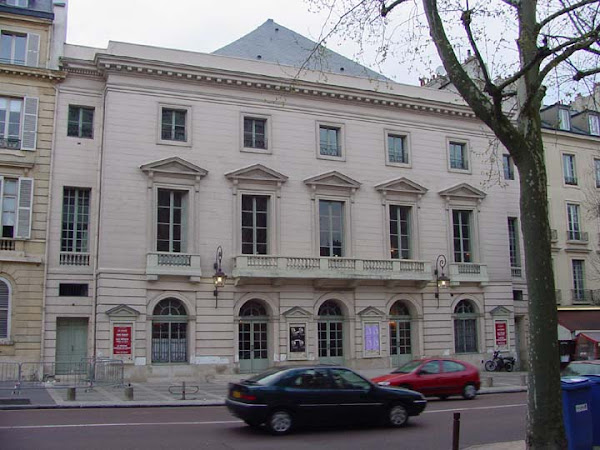However just beyond those better known galleries are 2 large lesser known rooms where it seems the museum curatorial and administrative staff have placed some ravishing French items that include some of the suite of furniture ordered by the Danish Minister Count Berndstorff when he lived in Paris in the mid 18th Century. That too is the subject for a future blog article and discussion. And among the other items of not insignificant interest to American lovers of French 18th Century decorative art, which will be discussed in this essay, is a partial exhibition of some of an overwhelmingly grand series of Beauvais wall hanging tapestries that Louis XVI ordered in 1789 along with a complimentary suite of Beauvais tapestry seat covers. These absolutely breathtakingly beautiful tapestries and their related seat covers were woven after cartoons by the artist Jean Jacques François Le Barbier, the elder. Some of the artist's cartoons are still conserved in the Moblier National in Paris.
This is the ill fated King of France as he appeared on the eve of the French Revolution in a portrait I took recently during a visit to the Revolutionary Galleries at the Musée Carnavalet in Paris.
This commission should be of particular interest to Americans as the documentation indicates that it was intended to be given to the first and then newly inaugurated American President, General George Washington! Below is the familiar Gilbert Stuart portrait in the White House.
Where the President would have placed such large tapestries in his modest official residences - first in New York City and then subsequently in Philadelphia - would have been a big question and quite a challenge! Regrettably, it was a challenge President Washington did not have to confront. The events of the French Revolution and the general turmoil of the 1790's that followed never allowed Louis XVI's well intentioned generous official gift to a valued ally and head of state to be presented or enjoyed by its intended recipient!
However in the 19th and 20th Century, the tapestries did eventually change hands and ended up in New York City's Metropolitan Museum where, at the time this blog is published in the summer of 2012, one tapestry and 2 giltwood Louis XVI fauteuils with their complimentary Beauvais upholstery can be viewed and examined by visitors and scholars. Below is a general view of the installation I photographed last year in June during a routine visit to the museum.
Worth noting is the addition of some lovely Louis XVI period furniture on the platform by David Roentgen...
The one of the four tapestries that is available for viewing at the moment is appropriately that one depicting America.
The flag of the fledgling republic is prominently seen being held by an attractive female allegorical and obligingly classically depicted figure in the centre.
While on the viewer's left, another fetching female allegorical figure is next to the column carrying an oval relief portrait of the American Republic's great friend and ally, Louis XVI.
In between the two is another female allegory of the Kingdom of France, carrying her shield covered with Fleur des Lys, over what art historians believe is a rather dejected reclining allegorical female figure suggesting a vanquished Britain.
Exotic birds and animals, trees and such also add a note of letting the viewer know this represents the New World!
Alas! The Met does not have the other three tapestry wall hangings out for the public to view at the moment. But I was able to scan the images from that invaluable 2-volume reference of European and Post Medieval Tapestries in the Metropolitan in which the entire known history of the tapestry set is documented.
This is a very exotic and evocative tapestry depicting Africa below. It is simply splendid! Under the shade of a tree and before a backdrop including an Egyptian pyramid, we see a majestically seated Negress with leopard skin garb next to her muscular negro attendant resplendently attired in finery including turban and plumes. Another nod to Ancient Egypt's splendors is the obelisk on the right. An allusion to the challenging terrain of the African deserts is the female allegorical figure on the right cupping her hands to get a drink of precious water as well as the appearance on the scene of a snake and other desert features. A zebra, an elephant and a lion are also depicted in all their customary epic scale that nearly dwarf the figures.
And below we see the distant splendors of the Far East in this tapestry representing Asia....
Closer to the hearts and homes of most 18th Century patrons would have been this depiction of Europe...
By no means of lesser interest is the tapestry seating, also following Le Barbier's designs, and executed by Beauvais. The MET has two of the fauteuils on public exhibition. The first of two chair covers depicting allegories of America is seen below. The menuiserie is not of the period however. The chair frames on which these tapestry covers are currently placed are in the style of Louis XVI. But the suite dates from the late 19th Century.
And the other of two chairs with tapestry covers celebrating America is seen below and can also be enjoyed by the public.
As already noted, not all of the suite is available... Consequently, in the museum's storage facilities, not currently exhibited, are other armchairs and an additional canapé celebrating Europe and America. It is illustrated below.
While yet another one has as its subject a celebration of Asia and Africa. It is seen below.
While it is sad and ironic President Washington was never able to enjoy this gift of undeniably Olympian splendor, it did eventually end up in his country's premier museum where it not only serves to further educate American scholars, dealers, collectors and connoisseurs of 18th Century French decorative art. But it is also a fitting place for this early tangible cultural reminder of a long historic Franco-American friendship to be on view for many to enjoy and to be conserved for generations to come!



































































